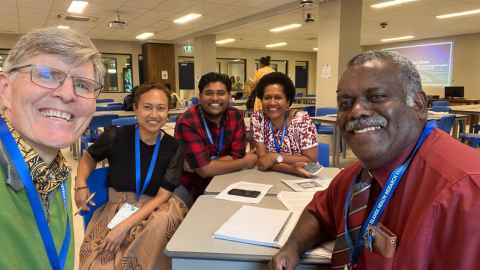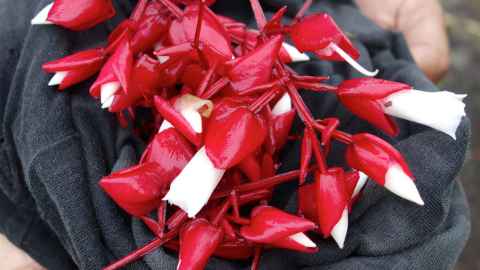Celebrate Macawa ni Vosa vakaViti, Fijian Language Week
3 October 2025
From 5-11 October, it's Fijian Language Week. 'Na noqu vosa me na tekivu mai vale – My language starts at home'.

Waipapa Taumata Rau, University of Auckland joins communities across Aotearoa in celebrating Fijian Language Week, honouring the heritage of almost 70,000 Fijians that call Aotearoa, New Zealand home.
For Sainimere Boladuadua, a public health physician and PhD candidate in the University’s Faculty of Medical and Health Sciences, this year’s theme is deeply personal.
With connections to Somosomo, Taveuni and maternally linked to Levuka, Yale, Kadavu, Sainimere says language is the vessel of cultural values that shape identity and community.
“Our language carries our values. Words like 'veirokorokovi', 'veirogorogoci', and 'solesolevaki', are more than terms - they are ways of living that hold our families, communities, and villages together,” she says.
- Veirokorokovi (Respect): Respect for elders, peers, visitors, and the environment, expressed through everyday gestures and protocols.
- Veirogorogoci (Listening/deferring to each other): Attentive, humble listening that fosters consensus and patience.
- Solesolevaki (Communal work): Working together for the collective good, from farming to community events.
- Lotu (faith): Christianity, woven into Fijian identity, reinforcing humility, gratitude, and service.

Access to healthcare a focus of doctoral research
Sainimere’s doctoral research focuses on improving access to healthcare for children with acute respiratory infections in Fiji, a leading cause of childhood illness and loss of life.
She says a key aspect of her work is examining how different worldviews influence healthcare access and how the community utilises those services.
“For Indigenous Fijians, this often involves navigating the intersections of the traditional Fijian worldview, a faith-based (most commonly Christian) worldview, and the Western biomedical health system,” she says.
“Understanding how people move between these spaces, and how this shapes their decisions to seek and engage with care, is central to my research.”
Sainimere recently completed a Fulbright research fellowship with the Johns Hopkins Center for Indigenous Health (JHCIH) in the United States. Working within the Infectious Diseases Prevention team, she collaborated with Navajo and White Mountain Apache communities on projects that integrate Indigenous knowledge with Western public health approaches.
Her work included contributing to RSV Surveillance in Native American Children and Adults (SuNA), a five-year study on respiratory infections among American Indian and Alaska native populations.
“This experience deepened my understanding of how Indigenous knowledge and Western health systems can complement each other to improve healthcare access and outcomes,” she says.

Woman of many worlds
As a woman of many worlds, she says her unique perspective and strong Indigenous foundation have a major impact on her research.
“I describe myself as a woman of many worlds - Indigenous Fijian, raised in an urban setting, connected to traditional society, while working in academic and professional spaces shaped by western health systems,” she explains.
“This perspective shapes my research and reminds me to ask, listen and learn.”
Fiji Language Week is an opportunity to celebrate Fijian values and ensure future generations thrive.
As Sainimere states, “Language starts at home, but its impact reaches far beyond - it shapes how we live, learn and care for one another.”
Fun facts
1. Fiji is an archipelago of 333 islands – but only about 110 are inhabited. The rest are pristine and untouched.
2. Taveuni Island straddles the International Date Line, so you can literally stand with one foot in “today” and the other in “yesterday.”
3. The rare tagimoucia flower, found only on Sainimere’s home island of Taveuni and recognised as Fiji’s national flower, does not grow anywhere else in the world. Her garlands at last year’s Fulbright ceremony were made with tagimoucia blossoms. Meghan Markle’s bridal veil featured flowers from all 53 Commonwealth countries, including kōwhai for New Zealand, teuila for Sāmoa, heilala for Tonga, and tagimoucia for Fiji.
4. Fiji is the “Soft Coral Capital of the World”, a title given by oceanographer Jacques Cousteau. Its reefs host over 390 coral species.
5. There are two native frogs found only in Fiji: the Fiji tree frog and the Fiji wrinkled ground frog.
6. Fiji has three official languages – English, Fijian, and Fiji Hindi – reflecting its cultural diversity.
7. 90 percent of Fiji’s land is owned by Indigenous Fijians (iTaukei) and held communally by clans.
8. Fiji won its first-ever Olympic gold medal in Rugby Sevens at the 2016 Rio Olympics, defeating Great Britain 43–7.